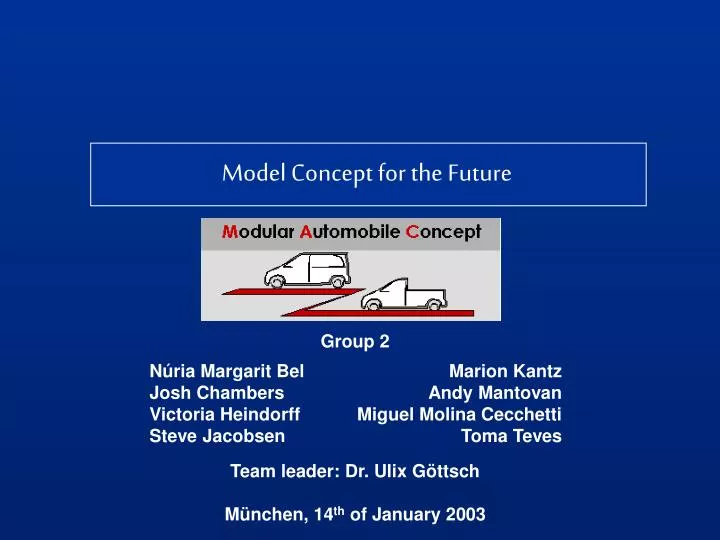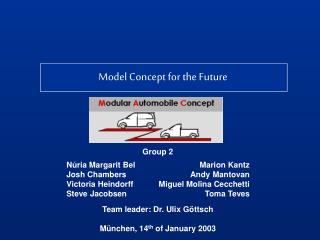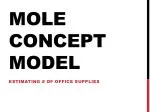
Model Concept for the Future
Presentation Transcript
Model Concept for the Future Núria Margarit Bel Josh Chambers Victoria Heindorff Steve Jacobsen Marion Kantz Andy Mantovan Miguel Molina Cecchetti Toma Teves Group 2 Team leader: Dr. Ulix Göttsch München, 14th of January 2003
Background and Motivation • Motivation • Traditional markets: USA, Europe, and parts of Asia are largely saturated • Difficult to significantly increase sales in a competitive market. • „Emerging Markets“ offer the most growth potential • New market opportunities in countries with quickly growing economies • The problem to solve: • Design a model program for a global car manufacturer. • Can there be a car that satisfies the demands of all emerging markets? • Could there be a “world car”?
Markets Are Different • Political and Legal Differences • Taxation • Environmental regulations • Customs • Safety standards • Labor laws • Social/Cultural Differences • Demographic trends • Family structures • Aesthetic preferences • Status and prestige • Environmental awareness • Economic Differences • Quality of infrastructure • Purchasing power • Availability of natural resources • Technological capability • Labor costs
The Current Markets • India • Imported used cars • Regionally produced discontinued cars • 2-stroke motorcycles • Middle East • Imported used American cars • Japanese cars • Luxury cars • Africa • Jeeps and Trucks • Latin America • Inexpensive cars • Midsize • Trucks (4WD) • Australia • Sedan with pick-up bed and big engines • Europe • Regionally produced cars • Family sedans/station wagons • Fuel efficient and diesel cars • USA • SUV’s • Midsize • Pick-ups • Mini-vans • California • Gas-electric hybrids • China • Inexpensive cars • Small cars • Motorcycles • Japan • Intelligent cars • Small cars • Hybrids • South East Asia • Fuel efficient cars • Inexpensive cars • Regionally produced cars
A Look at Emerging Markets Characteristics of the Markets: • Limited purchasing power • High sales taxes • High density urban areas • Low fuel qualities • Increasing use of IT • Inadequate transportation infrastructure • Lack of skilled labor • Limited distribution and service network
Meetings the Market Needs Characteristics of the Markets: • Limited purchasing power • High sales taxes • High density urban areas • Low fuel qualities • Increasing use of IT • Inadequate transportation infrastructure • Lack of skilled labor • Limited distribution and service network Characteristics of the Car: • Inexpensive • Compact • Fuel efficient • Simple to produce • Robust to quality of fuel • Durable • Easy to maintain • Tolerant to poor road conditions
The Solution Basic Configuration:(simple version, min. luxury) - “Safety Cell“(engine and passenger compartments) - Drive Train (engine to wheels) - Chassis and Suspension - Passenger compartment(Interior: front seats, dash board) Utility car Utility car (camper) Family car
The Solution Modular Additions: Exterior: - body panels (plastics) - bed for utility car (load zone) - doors for the family car - rear seat “safety cell“ - luxury upgrades(e.g. designer panels) - utility upgrades (e.g. cover, camper) Interior: - rear seats for the family car - luxury upgrades(e.g. navigation system or CD player)
Strategies for Success • Local government partnerships • Worldwide manufacturing • Consistent quality standards • Local investment • Reduced production costs • Brand name affiliation • Customer support • Standardized generic parts
Conclusions • Emerging markets offer greatest potential for sales growth in the near future. • A “Modular Automobile Concept” addresses the various requirements in different market regions. • Standardization and local cooperation can be used to reduce production costs. • Modularization allows market segmentation to maximize profit.
Group Photo Thank You!


















